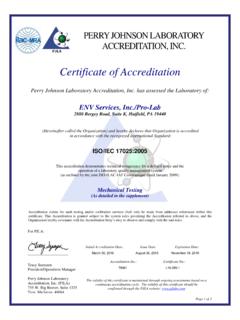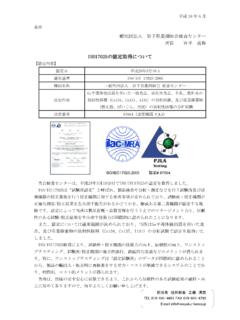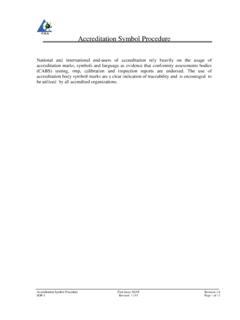Transcription of Status of Accreditation Within the United States Market
1 Status of Accreditation Within the United States Market Presented at the APLAC General Assembly Japanese Laboratory Accreditation Cooperation Technical Seminar 6 December 2010. by Roxanne Robinson Vice President/COO, A2LA. APLAC BOM member Topics US Government Philosophy of Regulation Types of US Accreditation Programs US Agency Use of 3rd Party Accreditation 2. Characteristics of the System In the United States , conformity assessment activities are not centrally organized Activitiesare a mix of government (regulations).
2 And private sector ( Market activities). Approaches vary among sectors 3. Regulatory Philosophy Rely on manufacturer's declaration of conformity legal system imposes severe penalties on defective or hazardous products consumers have broad access to information about products Dissatisfied customers can easily switch to a competing product laws and regulations on truth in labeling and advertising protect consumers as well 4. Regulatory Policy Executive Order 12866 Regulatory Planning and Review (September 1993) States that agencies should: Promulgate only such regulations as are required Analyze all costs and benefits of available regulatory alternatives, including not regulating Select approaches that maximize net benefits wherever possible 5.
3 Regulatory Policy Choiceof conformity assessment approach determined in part by assessment of risk: Agencies must conduct risk assessments of proposed new or revised regulations Inthe final analysis, risk assessment comes down to regulators exercising judgment Transparency and openness are important characteristics of the assessment process 6. Regulatory Policy NISTG uidance on Federal Conformity Assessment Activities August 2000. Outlines Federal agencies' responsibility for evaluating the efficacy and efficiency of their conformity assessment activities Each agency is responsible for coordinating its conformity assessment activities with those of other appropriate government agencies and with those of the private sector Out of date; A2LA has suggested revisions to specify use of the ILAC/IAF MRA/MLA.
4 7. Types of Government Agency Programs One on one approval Accreditation /qualification of private sector programs Recognition of accredited private sector programs 8. Federal vs. State and Local Government Programs Congress has given Federal agencies overriding responsibility for most health and safety regulation State and local governments are involved in: regulation of buildings and construction agricultural products workplace safety enforcement environmental safety enforcement 9. Last 30 Years There are seven ILAC signatory Accreditation Bodies providing broad based Accreditation to ISO/IEC 17025: NVLAP, A2LA, IAS, ACLASS, LAB, PJLA, AIHA.
5 Stillmany sector-specific programs that do not use ISO/IEC standards 10. Government Involvement 1989 Government Accountability Office Report: Of 20 different federal programs reviewed, there were 10 different terms for Accreditation used with at least 18 different meanings Different terms have different legal implications or reflect differences between various agencies'. legal authority to conduct specific programs Significant progress is being made now, but there is still duplication and complexity 11.
6 Consumer Product Safety Commission Wide Ranging Regulations being issued in Rapid Order to protect Children: First, Lead (Pb) in Paint in Children's Toys, Then, Mechanical Properties of Children's Toys . Then, Children's Jewelry . Then Recognizes ILAC MRA signatories 12. Federal Highway Administration One FHWA department recognizes ILAC MRA. signatories to accredit testing of highway crash mitigation equipment But another FHWA department refuses to recognize ILAC signatories and relies on the AASHTO Accreditation Program (AAP) plus Accreditation bodies recognized by the National Cooperation for Laboratory Accreditation (NACLA).
7 Which adopt the AAP assessment approach for construction materials laboratories 13. Food and Drug Administration Probably the world's largest regulatory body established to protect consumers' health, safety, and pocketbook for: Food,drugs, biologics, medical devices, animal feed and drugs, cosmetics, and radiation-emitting and combination products FDA food labs are getting accredited 14. Food and Drug Administration FDA Office of Regulatory Affairs Guidance Document: Submission of Laboratory Packages by Accredited Laboratories Applicable for biological products, drugs, devices and food Should be an ISO/IEC 17025 accredited lab Should also meet AOAC International Guidelines for Laboratories Performing Microbiological and Chemical Analysis of Food and Pharmaceuticals Should be accredited by an ILAC Signatory 15.
8 Food and Drug Administration Accreditation would allow the laboratory to submit and abbreviated package substantiating the testing performed: Importdocumentation (if applicable). Summary of Analysis Affirmation by Lab Director Legislation pending that MIGHT require Accreditation of all food testing labs by ILAC. signatories 16. Department of Agriculture Regulates certain food and agricultural products to protect consumers' health, safety, and pocketbook, specifically: meat, poultry, dairy products and raw agricultural products Accredits meat and dairy labs User fees imposed Does not use ISO/IEC 17025 & does not follow ISO/IEC 17011.
9 Relies heavily on proficiency testing programs USDA labs are getting accredited; usually precursor to requiring Accreditation of others 17. Health and Human Services Commission for Medicare Services (CMS). program recognizes Accreditation bodies in both the public (state government) sector and private sector ( , CAP, COLA, Joint Commission). Does not use ISO/IEC 17011;. Does not use ISO/IEC 17025 or ISO 15189; uses CLIA (1988) as Accreditation standard Will not recognize ILAC MRA signatories but CMS is starting to look closer at management system requirements 18.
10 Environmental Protection Agency National Environmental Laboratory Accreditation Program (NELAP) for potable and non potable water and solid/hazardous waste testing Recognizes state government agencies as the sole Accreditation authorities; private sector ABs are assessment bodies But state agencies' Accreditation programs are taking severe criticism; EPA. may recognize 3rd party Accreditation Recognition criteria based on ISO/IEC Guide 58 with intention to move to ISO/IEC 17011. Uses ISO/IEC 17025, with onerous technical applications Recognizes A2LA to accredit supportive proficiency testing providers 19.












